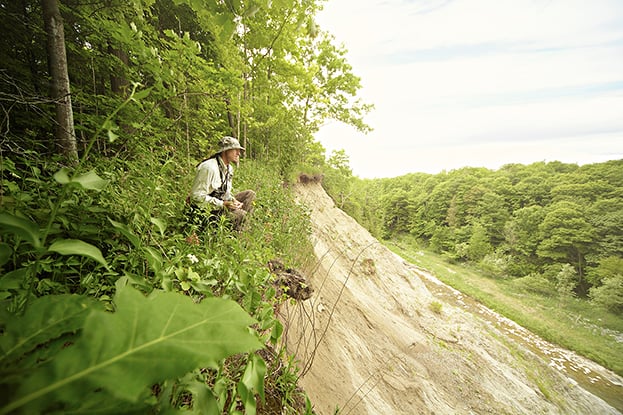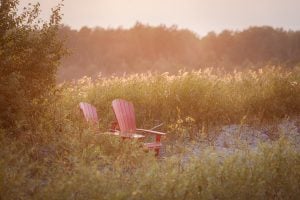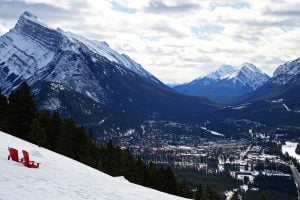Lake Ontario has long drawn summer visitors to Rouge Park, but it’s hoped that new hiking trails and a visitor’s centre will attract more people to the park’s interior. (Photo: Peter Andrew Lusztyk)
A year and a half later, with Parks Canada having released their park concept, Robb and Kevin O’Connor, president of Friends of the Rouge Watershed, are giving me a tour by road. They have come to think that the sometimes-impotent Rouge Park Alliance — disbanded last year to make way for Parks Canada — looked pretty good.
Robb drives to the proposed northern boundary of the park. It ends abruptly at a subdivision where 19th Avenue meets York Durham Line road. “Parks Canada says Rouge Park is supposed to link Lake Ontario to the foot of the Oak Ridges Moraine,” says Robb, referencing the 160-kilometre- long stretch of rolling glacial till across the top of the Greater Toronto Area that’s provincially protected. “This isn’t the foot, this is the toe. These boundaries were based on politics, not hydrology.” He shows me a map that indicates the northern end of the park does overlap the moraine, but not by much. Then he points east across the road to more than 40 square kilometres of land within the provincial greenbelt that’s already owned by the federal government. This federal land, the map shows, extends four kilometres farther north than the proposed park, deeper into moraine territory.
The land was excluded from the study area that the Rouge Park Alliance provided to Parks Canada. Robb believes that the broad interests of a larger, ecologically healthy park fell victim to the narrower interests of farmers who are already leasing ground in these off-limits federal lands. He says he doesn’t blame Parks Canada, and that electoral politics have put a limit on the park, at least for now.
Most worrisome to Robb and O’Connor is Parks Canada’s silence on the issue of a 600-metre-wide corridor along the Little Rouge River, where ecology should trump all else, something that has been enshrined in every planning document since the park’s creation. He doesn’t see it explicitly mentioned in Parks Canada’s 18-page park concept. Robb cites a 2013 Environment Canada study called How Much Habitat is Enough?, which argues that the minimum width of a forested area needed to create interior forest habitat is 500 metres. “It’s only then that you get a natural system, with a closed tree canopy that is safe from edge effects like an abundance of raccoons, skunks, crows and invasive species,” he says.
Despite the lack of mention in the park concept, Veinotte says Parks Canada is “committed to an ecological connection,” and points out that the strategic management plan for the park, a significantly more detailed document than the concept statement, has yet to be written.
O’Connor, however, still wishes the starting point were a little more ecology-minded. “This is not what we were advocating for,” he says. “Nature isn’t the focus. If people are put first, we will overuse and abuse it. In the 1990s, the Rouge Park Alliance chose the best long-term vision for this park. We are asking for the same. I want to come here before I die and look at something magnificent, not a tattered quilt.”
But “tattered” is a word some might use to describe the current park, operating as it is with only six staff, relying largely on volunteer labour for conservation work.
Serena Lawrie is a board member of the Rouge Valley Foundation, the organization that operates the Rouge Valley Conservation Centre, which runs regular guided walks through the park. As she stands outside the centre’s farmhouse headquarters waiting for a school group, I ask her if the park is being adequately protected as is. “Not really,” she says, hesitantly. “There isn’t much money. The park hasn’t done a major, season-wide species inventory since the late 1990s. The trails are falling apart. People don’t know where to go, so they make their own trails. But nobody polices it.” Lawrie notes that the publicity generated by Parks Canada’s arrival has already resulted in more people visiting, ultimately a good thing for her organization, which tries to raise awareness for the park. “It used to be mainly retirees, but there are a lot more young people now,” she says.
Speaking of young people, two classes from Scarborough’s St. Kevin Catholic School have arrived. Teacher Neil Kulim herds them into groups. Kulim tells me how his father brought him to the valley in the 1980s to ride bikes, get lost, climb ravine walls and explore crumbling homesteads. In turn, Kulim has been bringing classes to the park since 2007.
“I thought we were going to lose most of this place in the 1990s,” he tells me, gesturing past the end of a meadow along the Lookout Trail toward houses on the far side of Meadowvale Road. “I remember knocking on doors in that neighbourhood in 1999 and handing out flyers about the park. People would ask me, ‘What’s the Rouge Valley?’”
A group leader asks if anyone knows what a dung beetle is. Half the hands go up. Kulim points to a student near the back in brand-new rubber boots and tells me that last week the student didn’t know what a canoe or coyote was. I follow one boy who stops in front of a puddle on the trail. “These Jordans cost $200,” he points out, before steering his sneakers well clear of the wet. We descend to a gravel flat beside the kneedeep Little Rouge River. The students investigate tentatively. One of them asks Kulim if they can touch the water.
“Hey, I found a turtle,” one kid yells.
“No, you found a frog,” corrects another.
As the kids explore, I ask Joanne Willock, a parent volunteer, how often she visits the park. She looks at her son standing on the bank. “It’s embarrassing,” she says. “I didn’t even really know this was here. We don’t live that far away. All these housing developments around here, they’re called ‘Valley This’ and ‘Valley That,’ but you lose sight of what a real valley is. He’s nine and this is the first time he’s walked in a river.” I look over and see that despite the initial apprehension, the childhood inclination toward getting one’s feet wet has taken over. Those in sneakers are up to their ankles. The tops of more than one rubber boot have been breached.
Even the kid who didn’t want to get his running shoes dirty has to be called back from the gravel bar he’s wandering down. When he returns, clay has caked his laces. It’s taken five minutes to turn him into a poster child for Parks Canada’s new stated aim of introducing kids, city-folk and new Canadians to nearby nature.
It’s later that same afternoon that I’m looking out over raccoons and swans at the pond with Andy McKinnon, the amateur naturalist. He points to a stand of birch trees beyond the north bank that he says were some of the first planted in the park. Last year, volunteers planted 100,000 saplings across the park. McKinnon has mixed feelings about such restorations, and believes that, ideally, nature needs only time to heal. But he knows that human influence is not going away in Rouge Park. “I’ve seen more interest in the park already,” he says. “There are more and more people around.”
That there are more visitors to the park no doubt pleases those who envision Rouge Park as a gateway to nature. And while McKinnon might worry there could be a flood of people, he hopes Parks Canada can strike the right balance. “Parks Canada has a good reputation,” he says. “It could be good for the park to be managed by one body… if they get the legislation right.”
He stops as a dark brown head surfaces beside the near shore. It dives forward, and a slender back arcs above the surface before leaving only ripples. “There she is,” says McKinnon, pointing at the otter. Before long, we spot two others — it’s a mother and her two pups — and McKinnon recalls watching the mother drag her young into the water for their first swim. There have been a few recent sightings like this, confirming that, after a 30-year absence, otters have returned to the Rouge Valley. McKinnon isn’t convinced there’s a viable breeding population yet, but it’s a good start.
The otters’ foothold might seem tenuous, but as Veinotte sees it, for Parks Canada’s urban mission to succeed, they will need to safeguard populations like this. She disagrees that more people enjoying the park will threaten its plants and animals. “The success of one depends on the other,” she says. In other words, if Parks Canada wants to introduce people to nature, there had better be nature to behold upon arrival.
Explore Canada’s national parks, national historic sites and national marine conservation areas with students using Canadian Geographic Education’s Parks Canada giant floor map.
Parkland versus farmland
Although forested trails and river valleys will be the signature attractions of Rouge National Urban Park, agricultural land accounts for more than half of the 58 square kilometres in Parks Canada’s study area.
The land is owned by the Toronto and Region Conservation Authority and the federal and provincial governments, and leased to private farmers, who mainly plant cash crops such as corn and soybeans.
Parks Canada spokesperson Geneviève Patenaude calls agriculture “an important element of the long-term vision” for the park, but says they are in discussions with farmers to develop environmental farm plans.
A furrowed field may not be everyone’s idea of prime parkland, but agricultural land does offer an ecological buffer from urban areas by providing wildlife corridors, habitat and food. Still, many environmentalists, including Jim Robb of Friends of the Rouge Watershed, would like to see more of the farmland renaturalized, and question whether having so much land under private lease within a public park is appropriate.







